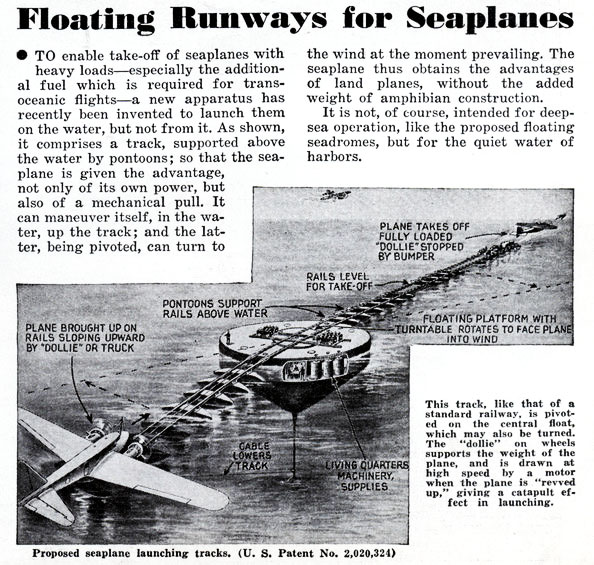The design pictured below – for “a track, supported above the water by pontoons,” forming a sea-based airport on top of which planes could land – was published in Science and Mechanics back in 1936.
The project was “not, of course, intended for deep-sea operation, like the proposed floating seadromes, but for the quiet water of harbors.”
 [Image: From Modern Mechanix, originally published in 1936 – the same year Raiders of the Lost Ark takes place, on a completely unrelated note].
[Image: From Modern Mechanix, originally published in 1936 – the same year Raiders of the Lost Ark takes place, on a completely unrelated note].
Those deep-sea “floating seadromes,” however, are really quite interesting.
An idea by engineer Edward R. Armstrong, seadromes were “steel islands” that would be “anchor[ed] 375 miles apart across the Atlantic.”
[Each seadrome] will have an unobstructed airplane runway 1,200 ft. long by 200 ft. wide. At the mid-sides the platform will project to give room for a hotel (with restaurant and bar), hangars, storage sheds, weather bureau, offices, hospital wards, lighthouse. Platform and buildings will be 80 ft. above calm water level. Because no Atlantic waves have ever been seen more than 45 ft. high, it is improbable that the runway ever will be awash. The buoyancy columns with their stabilizing disks will reach 160 ft. below water level. That is considerably deeper than any wave action has ever been noted.
In other words, the seadromes wouldn’t fare too well if they got hit by a rogue wave…
We learn that Armstrong “long planned to anchor his first full-size seadrome midway between Manhattan and Bermuda. Studying hydrographic charts of the region he figured that there must exist a high spot on the ocean floor about where he would like it. He asked Secretary of the Navy Charles Francis Adams to send a survey ship to check his calculations. He was right.”
There was, indeed, “a little plateau” out there, to which one of Armstrong’s floating islands could anchor.
By flying from one seadrome to the next, Armstrong believed that aerial transit time between North America and Europe could eventually be cut to “as low as 20 hrs.”
According to American Heritage, Armstrong’s “chain of seadromes would stretch across the Atlantic to the Azores, from which planes would continue on to Spain, with connections to the rest of Europe. The seadromes would be equipped with patrol boats and Seasleds so that, as a newspaper article explained, ‘a disabled plane forced down … between seadromes, could be reached in five hours or less.'”
However, the seadromes were also extra-constitutional spaces located outside landed sovereignty. Some interesting governmental questions arise here – such as: If you were born out there, and raised there, and educated there, what passport would you hold? What if no country would receive you – leaving you to wander, Odysseus-like, from one seadrome to the next, flying the Atlantic trade winds in a state of infinite anti-residential exile? To whose laws would you be bound?
The idea of floating airports has mutated into a variety of similar such schemes, meanwhile, including so-called modularized ocean basing systems for the U.S. Navy, also known as mobile offshore bases.
And then, of course, there’s SeaCode…
And check out the 1933 movie F.P. 1, about the construction of a floating platform in the middle of the Atlantic.
I suspect this idea turned into aircraft carriers, which would probably seem completely absurd to a 19th century person. A floating mobile landing platform for heavier than air flying machines? Next you’ll be telling me rocks fall from outer space.
there’s a nice design for a floating airport in the 1932 book ‘Horizons’ by Norman Bel Geddes
Looks like a giant sea-banjo.